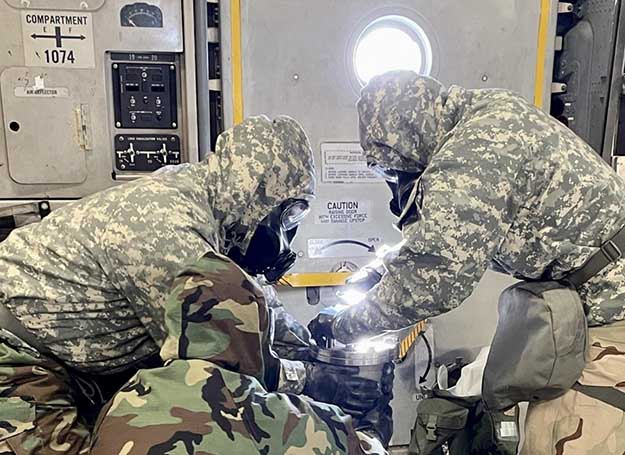JOINT BASE LEWIS-MCCHORD - U.S. Army Chemical Corps soldiers trained for Weapons of Mass Destruction Technical Escort missions with U.S. Air Force Reserve airmen, March 17-20, on Joint Base Lewis-McChord.
Soldiers from the 9th Chemical Company (Technical Escort) and airmen from the Air Force Reserve's 446th Airlift Wing proved their mettle during Operation Iron Flight, an exercise designed to practice packaging and transporting WMD material during combat operations.
Army Technical Escort units assess, sample, detect, verify, render safe, package and escort chemical and biological hazards. The specialized units also conduct biological surveillance and provide limited consequence management support to military forces and civil authorities.
The Joint Base Lewis-McChord, Washington-based 9th Chemical "Bounty Hunter" Company is part of the 110th Chemical Battalion (Technical Escort), 48th Chemical Brigade and 20th Chemical, Biological, Radiological, Nuclear, Explosives (CBRNE) Command, the U.S. Department of Defense's premier deployable and multifunctional all hazards formation.
The Aberdeen Proving Ground, Maryland-headquartered 20th CBRNE Command has soldiers and civilians on 19 bases in 16 states who confront and defeat the world's most dangerous hazards in support of joint, interagency and allied operations around the world.
Maj. Brian Lind, a U.S. Air Force Reserve C-17 Globemaster III pilot assigned to the 97th Airlift Squadron, said the soldiers and airmen overcame a language barrier during the exercise.
"Army and Air Force use different acronyms," said Lind. "The Army is one of our primary customers and this mission allowed us to practice our communication. This training was unique because the Army requested pressurization changes to test the limits of their pressurized vessels. We flew at different altitudes using a tactical descent to accommodate the requested training scenarios."
Staff Sgt. Trevon O. Robinson, the motor sergeant from the 9th CBRNE Chemical Company, drove a light medium tactical vehicle onto a C-17 aircraft for the first time.
"This training was awesome," said Robinson. "This helps us be prepared for the future."
Chief Warrant Officer 2 Daniel B. House from the 9th Chemical Company said the exercise helped the company to hone tactics, techniques and procedures while integrating with the Air Force Reserve unit.
"It was good practice all the way around," said House. "Building up to be more integrated and be more prepared for movements in the air."
Capt. Benjamin C. McCoy, the commander of the 9th Chemical Company, said Operation Iron Flight gave his soldiers a chance to hone their technical escort skills.
"Soldiers have experiences that give them the confidence to perform the same tasks again in the future," said McCoy. "My headquarters has a better understanding of what it means to deploy equipment by air - troubleshooting the deployability of our rolling stock before the call comes."
McCoy said his highly specialized company protects maneuver forces by escorting hazardous materials out of an area of operations and aiding the command in identifying a hazardous substance with the help of laboratories outside of the theater of operations. McCoy said he was grateful for the opportunity to train with the airmen who would help them to accomplish their life-saving and mission-enabling mission.
"I'd like to thank the 446th Airlift Wing for helping us to stay mission ready. There's nothing like working with aircraft and I'm thankful for every opportunity," said McCoy, a native of Landstuhl, Germany, who has served in the Army for seven years and the past two years as a company commander. "I really enjoyed accomplishing Air Force and Army training objectives in the same mission. They enabled my soldiers to train how we would fight - in a joint environment."





Read Comments